
Shrubs can diversify wildlife habitat planting schemes and are easy to incorporate on any property. To visualize how shrub planting increases habitat diversity, think of a forest.
Typically, forests include (1) tall trees (canopy), (2) smaller trees and shrubs (sub-canopy) and (3) herbaceous plants and ground covers (understory). Unless forested tracts are already present, most properties have only trees and ground covers, often lawns, with little in between. Planting shrubs then becomes a way to attract those wildlife species that need this plant layer to satisfy their habitat needs.
Shrubs as Habitat
Shrubs can serve as habitat in many ways. Flowering shrubs can produce nectar to feed bees, butterflies and hummingbirds. Berry-producing can shrubs feed songbirds, upland game birds and many mammals including deer, squirrel, fox and chipmunks. Wild animals use leaves, twigs and buds of the plant itself for food. Shrubs can also provide shelter from predators or extreme weather, or to nest and raise young, especially when massed. Evergreen, thorny or dense-branching shrubs usually offer the best shelter.
When selecting shrubs, it is important to keep in mind the flowering and fruiting nature of the species. Try to incorporate shrubs that produce berries at different times of the year so that a food supply is always present for berry-eating wildlife. Some shrubs are dioecious, meaning that male and female flowers are born on separate plants. So, if your goal for a dioecious shrub is to have it produce berries, then it is important to plant both a male and female shrub for pollination.
Where to Plant Shrubs
Landscaping uses for shrubs are as varied as the choice of plants. Shrubs may be planted around the foundation of the house or as borders that serve as backdrops for perennial and annual plants. On large tracts, shrubs can be planted along cropland and forest edges or incorporated into hedgerows of trees and shrubs. Hedgerows planted between cropland provide connectors or wildlife travel lanes between larger blocks of contiguous habitat (i.e. forest, fallow fields or wetland habitats). Linking these larger blocks is increasingly important as suitable wildlife habitat becomes fragmented by development. Incorporating evergreen and thicket-forming shrubs in hedgerows ensures that shelter components of habitat are met.
Selection of Shrubs
Before purchasing a shrub or two, consider several criteria before making a purchase. First, determine the shrub's purpose: Do you want the shrub to provide food, cover or both? Second, choose plants that are compatible with the site. Be sure to research light and soil conditions required for your shrub. Third, consider maintenance needs of the desired species. Shrubs planted near the house can be watered easily during dry weather but watering may not be practical in large scale plantings on farms. Pruning can also be done easily in backyard situations but is not practical in large scale plantings. As a general rule, only light pruning is recommended for shrub wildlife plantings because there is a danger of pruning away future food supplies if done at the wrong time of year. Pruning also reduces the plants usefulness as wildlife shelter; backyard wildlife shrubs should be allowed to attain a natural form. Some vigorously-growing shrubs respond well by being cut back to six inches in the fall and will grow even bushier than before. Local nursery or garden center personnel can advise you on what shrubs to select depending on the intended need.
Wildlife Shrubs
The following list includes shrubs native to Maryland that produce berries consumed by various species of wildlife. It is good to select plants that fruit at different times of the year so your property offers food throughout the year. The types of wildlife attracted (birds, small mammals and/or beneficial insects) are highlighted for each species. Shrubs that have more detailed information in the Habi-Chat archives are hyperlinked.
Plant Name | Photo | Attracts | Berry Timing | Soil |
Elderberry
(Sambucus canadensis) |
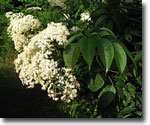
|

|

| | Aug-Sept | Dry-Wet |
Highbush blueberry
(Vaccinium corymbosum) |
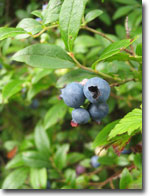
|

|

|

| July-Aug | Dry-Wet |
Huckleberries
(Gaylussacia spp.) |

|

|

| | July-Oct | Dry-Wet |
 Northern bayberry Northern bayberry
(Morella pensylvanica) |
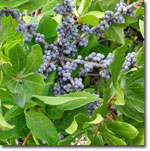
|

|

| | Sept-April | Dry-Wet |
Red chokeberry
(Photinia pyrifolia) |
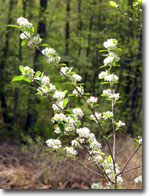
|

|

| | Sept-Dec | Dry-Wet |
 Red-osier dogwood Red-osier dogwood
(Cornus sericea) |
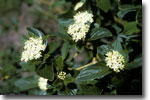
|

|

|

| Aug | |
Spicebush
(Lindera benzoin) |

|

|

|

| Sept-Oct | Moist-Wet |
Sumacs
(Rhus spp.) |
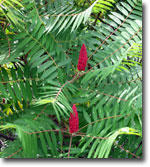
|

|

|

| July-Jan | Dry-Moist |
Viburnums
(Viburnum spp.) |
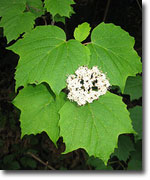
|

|

| | Aug-Dec | Dry-Wet |
 Winterberry Winterberry
(Ilex verticillata)
|
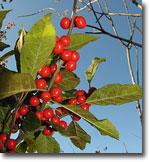
|

|

| | Aug-Feb | Moist-Wet |
Invite Wildlife to Your Backyard!
For more information, please contact:
Maryland Department of Natural Resources
Wildlife and Heritage Service
Tawes State Office Building, E-1
Annapolis MD 21401
410-260-8540
Toll-free in Maryland: 1-877-620-8DNR
[email protected]
Acknowledgements:
- Photograph of Huckleberry shrub in meadow, courtesy of NPS, Photo by JR Douglass; 1970.
- Photograph of Bayberry with fruit, courtesy of the U.S. Forest Service
- Photograph of Red osier dogwood, by Richard A. Howard Image Collection, courtesy of Smithsonian Institution, USDA-NRCS PLANTS Database
- Photograph of Spice Bush foliage, courtesy of Tim McDowell Assistant Professor of Biological Sciences, East Tennessee State University
- All other photographs by Kerry Wixted